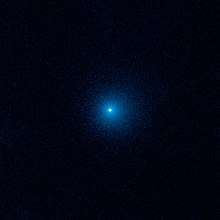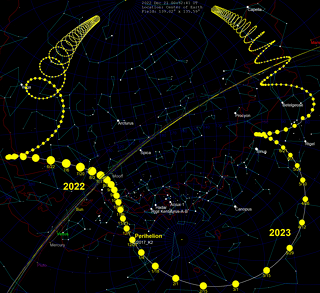C/2017 K2
 June 2017 by Hubble's Wide Field Camera 3[1] | |
| Discovery | |
|---|---|
| Discovery date | 21 May 2017[2] |
| Orbital characteristics [ A] | |
| Epoch | 2022-12-07 (2459920.5) |
| Observation arc | 4.55 years |
| Aphelion | ~45000 AU[lower-alpha 1] |
| Perihelion | 1.7969 AU[3] |
| Eccentricity | 1.0008 |
| Orbital period |
millions of years inbound[lower-alpha 1] ~26000 years (outbound) |
| Inclination | 87.563° |
| Earth MOID | 1.10 AU (165 million km) |
| Jupiter MOID | 1.29 AU |
| Dimensions |
Rn between 14 km (8.7 mi) and 80 km (50 mi)[4] maximum Dn ~18 km (11 mi)[5] |
| Next perihelion | 2022-Dec-19[3][6][lower-alpha 2] |
C/2017 K2 (PANSTARRS) is a non-periodic comet with a hyperbolic orbit, discovered in May 2017 at a distance beyond the orbit of Saturn when it was 16.09 AU (2.4 billion km) from the Sun. Precovery images from 2013 were located by July.[7] It has been in the constellation of Draco since July 2007. As of April 2018, the 3-sigma uncertainty in the current distance of the comet from the Sun is ±30000 km.
Research with the Canada–France–Hawaii Telescope (CFHT) infers the comet nucleus to have a radius between 14 and 80 km, so there is a chance the nucleus could be as large as C/1995 O1 (Hale-Bopp)".[4] But research with the Hubble Space Telescope (HST) estimates the nucleus to have a circular equivalent diameter of less than 18 km.[5]
Around 2022-Jul-06 the comet will cross the celestial equator and then around 2022-Jul-14 it will pass 1.8 AU (270 million km) from Earth.[8] It will reach perihelion around 2022-Dec-19, close to the orbit of Mars.[3][6][lower-alpha 2]

Path of C/2017 K2 in the sky
References
- ↑ "Distant active comet C/2017 K2". www.spacetelescope.org. Retrieved 3 October 2017.
- ↑ "MPEC 2017-K35 : COMET C/2017 K2 (PANSTARRS)". IAU Minor Planet Center. 2017-05-24. Retrieved 2017-10-21. (CK17K020) (3 day obs arc)
- 1 2 3 "C/2017 K2 (PANSTARRS) Orbit". Minor Planet Center. Archived from the original on 2017-11-13. Retrieved 2017-11-13.
- 1 2 Meech, Karen (2017). "CO-Driven Activity in Comet C/2017 K2 (PANSTARRS)". The Astrophysical Journal Letters. 849 (1). arXiv:1710.03876. Bibcode:2017ApJ...849L...8M. doi:10.3847/2041-8213/aa921f.
- 1 2 Jewitt, David (2017). "A Comet Active Beyond the Crystallization Zone". The Astrophysical Journal. 847 (2). arXiv:1709.10079. Bibcode:2017ApJ...847L..19J. doi:10.3847/2041-8213/aa88b4.
- 1 2 Seiichi Yoshida. "C/2017 K2 ( PanSTARRS )". Seiichi Yoshida's Comet Catalog. Retrieved 2017-11-15.
- ↑ "MPEC 2017-N26 : COMET C/2017 K2 (PANSTARRS)". IAU Minor Planet Center. 2017-07-01. Retrieved 2017-10-21.
- ↑ Hubble Spots Farthest-Ever Incoming Active Comet September 29, 2017
Notes
- 1 2 Computed with JPL Horizons using a barycentric solution. Ephemeris Type: Orbital Elements / Center: @0 (To be outside planetary region, inbound epoch 1950 and outbound epoch 2050)
- 1 2 Perihelion passage: Given perihelion is still 5 years away, an epoch of 2022 gives a more accurate perihelion date that properly accounts for planetary perturbations. An epoch 2017 unperturbed two-body solution (Sun+comet) gives a date of 2022-Dec-21. Integrating the orbit with JPL Horizons which accounts for planetary perturbations gives a date of 2022-Dec-19. The Minor Planet Center's Epoch Dec 2022 solution also gives a date of 2022 Dec. 19
External links
- A Comet Active Beyond the Crystallization Zone
- MPEC 2017-K90 : COMET C/2017 K2 (PANSTARRS)
- NASA's Hubble Observes the Farthest Active Inbound Comet Yet Seen
- Note on the dynamical evolution of C/2017 K2 PANSTARRS (arXiv 2018)